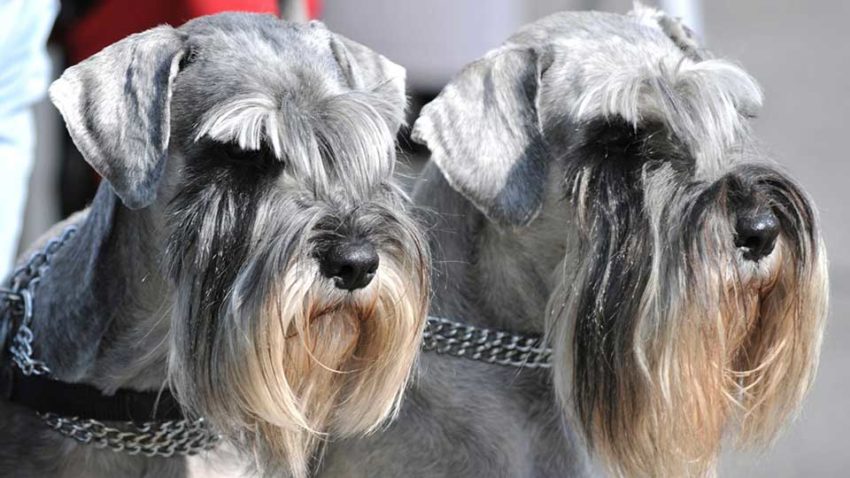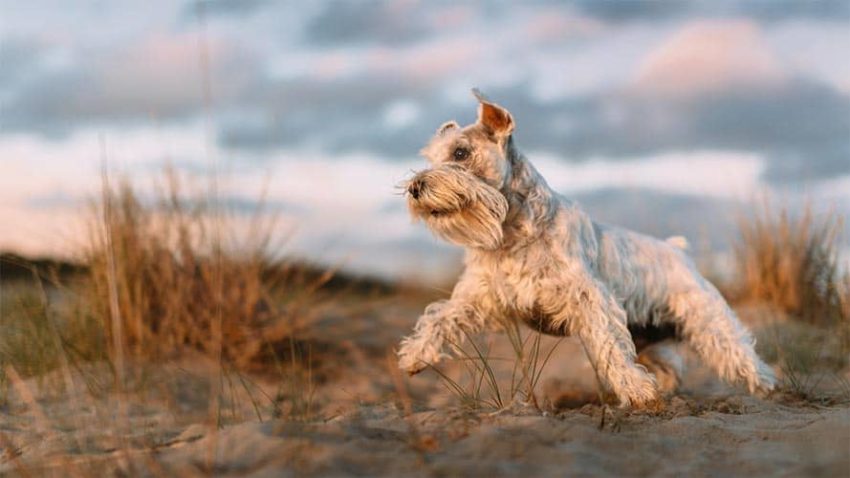Schnauzer breeds are at the top of the list of most intelligent breeds of dogs – this is reflected in their quick learning in new situations.
It’s also known that Schnauzer is a great breed for both an individual and a family.
Having that in mind, Schnauzers require human attention, and they will actively seek it out.
It’s because they love spending time with their humans.
(Let’s face it, we are very interesting to them – not only because we make funny noises when we see those wise bearded faces, but also because we give treats and cuddles.)
To have a well-behaved Schnauzer both at home and in other environments, socialization and obedience training are a must.
An important thing is to start with training as soon as you get the Schnauzer puppy. That will prevent your Schnauzer from becoming too aggressive or possessive in the future.
We will go over 5 basic commands every Schnauzer has to learn. And the last one could save your Schnauzer’s life.
But before we start explaining each command, let’s see what are some tips that will make training easier and more enjoyable.
6 Tips For Training Your Schnauzer
Training your Schnauzer does NOT have to be difficult and complicated.
By following a few simple steps, training can be pleasant and rewarding for both you and your wise-looking friend.
1. Make it fun
This is one of, if not the most important tip when training your Schnauzer.
Dogs, especially Schnauzers, are very intuitive creatures.
Make sure that you are in an enthusiastic mood when you begin the training session. Have their favorite treats on hand, and be ready to give lots of verbal praise.
In addition, always exercise your pup before the training. By doing that, you allow your little friend to burn out the excess energy.
2. Make it natural
Remember that your Schnauzer puppy is not fully grown. It also lacks control of its body functions.
Having that in mind, be ready to reward all wanted behavior even when you are not having a training session. By doing that, your pup is likely to repeat the wanted command in the future.
Likewise, ignore unwanted behavior – don’t acknowledge your Schnauzer when doing something you don’t like.
3. Keep it consistent
It is very hard for the puppy to understand expectations if they often change.
Also, it’s important to keep the same expectations between people.
It will take much longer to teach the puppy a command if, for example, your children let the pup sleep on the bed but you and your spouse insist that the puppy stays off the furniture.
Make sure that everyone in the house is on the same page and uses the same commands.
4. Get in a routine
We, humans, are creatures of habit and routine – the same goes for our four-legged friends. Try your best to schedule a routine for training.
This will help your pup to understand the difference between play and training – it will help them focus.
5. Patience is the key
Remember that Schnauzer puppies are just like toddlers. Their attention span is very short – sound and movement can easily distract them.
You can turn that in your advance. Use funny noises and fast movements to get the puppy’s focus back to you.
Just relax! They will pick up the new commands and behaviors faster than you think.
6. Never hit a puppy
A Schnauzer loves bonding with a human – the stronger the bond, the easier training gets.
You can weaken that bond if there is negative physical contact between the owner and the puppy.
Rewarding positive behaviors, and using sharp and firm “No” followed by taking away attention will be more beneficial than physical punishment.
The Basics Of Schnauzer Training
Now that you have a good understanding of the mindset behind training your smart furry friend, you can start it with these basic commands.
- Sit
- Have your puppy in front of you
- Show him that you have a yummy treat in your hand
- Slowly move the treat above and over his head towards his tail
- His head should go up as he tries to reach the treat, and his bottom should, naturally, go down into the “sit” position. Give the command “sit” at the moment the puppy’s bottom touches the ground.
- Give him a treat and praise him verbally.
Do not push his bottom down to make him sit, as a result, he is likely to push up against your hand.
- Down
- Ask your pup to sit and show him the treat in your hand.
- Move your hand slowly down towards the ground in front of him. He should follow your hand as he nibbles the treat and lays down. Use the command “down”.
- Give him the treat and praise him.
After your pup learns to lay down from a sitting position do the same thing starting from the standing position.
- Stay
- Ask your puppy to sit or lay down.
- Take one step away as you say the command “stay”. Wait for three seconds.
- Step back to him, treat him and praise him.
- If he gets up, ask him to sit or lay down again and repeat the procedure.
- Gradually increase the distance once your pup is doing a short “stay” command correctly.
- Come
Make sure that you have your puppy’s attention in a quiet and distraction-free environment.
- Start this activity by being a few steps away from the puppy.
- Make funny noises and swift movements to make your puppy want to come to you.
- As he approaches you, use the command “come”
- Immediately reward him once he comes to you.
- Gradually move further back as your pup masters the short distance.
- Leave it
Teaching your Schnauzer pup to “leave it” can be a great way to avoid dangerous and disgusting situations.
The command “leave it” can literally save your pup’s life!
Before you start, it’s a good idea to have 2 different kinds of food – a high-reward treat (hotdog, chicken) and a common treat (dry dog food or cheese).
You should use high-reward to treat the puppy and common food to temp the pup.
- Have your pup in front of you. Put the common treat in one hand and the high-reward treat in the other.
- Offer an open hand with the common treat in front of the pup as you say the command “leave it”.
- Your pup will probably go for the food, that’s when you need to close your hand and wait for the puppy to back off.
- Once it backs off, open your hand again and say “leave it”.
(You are looking for a moment when your puppy decides to leave the food alone) - Reward your fluffy friend with a high-reward treat and lots of verbal praise when he doesn’t go for the food in your hand for a moment. (gradually increase the time you wait as your pup starts getting better at waiting for the cue)
- Repeat the process for as long as it takes your pup to realize that the only way he gets food is when he doesn’t go for it.
Take this practice to the next level by throwing the common treat on the ground close to your puppy, instead of holding it in your hand.
To ensure that your pup won’t get the food put him on a leash or be ready to cover the food with your hand if he goes for it.
The imperative is that your pup doesn’t take the food after you say the command “leave it”!
If that happens, you have to go back to the very beginning.
Schnauzer Training DOs

- Practice in your home first, before training commands in public areas.
- Start training as soon as you get the Schnauzer puppy.
- Keep sessions fun and short (5-10 minutes max).
- Reward or treat him randomly, once the new command has been learned – but still, remember to verbally praise your pup every time.
- Try to use hand signals along with your verbal commands
- Keep commands consistent and clear.
- Take your time and be patient.
- Stick to one new command per training session to avoid confusion.
- Try to finish on a high note – your pup is more likely to want to train again next time!
- Give your puppy an enjoyable chewy treat to relax with at the end of a session, or he may become frustrated when the treats stop!
Schnauzer Training DON’Ts

- If you see your Schnauzer puppy got bored, stop the training.
- Physically punish him or shout – it will make him scared of you and may cause him to become aggressive.
- Train him if he is hungry – it’ll make him frustrated and he won’t enjoy training.
- Chase the pup when you want him to come – he’ll think it is a game and will run away even more.
- Do your early training in an area with lots of distractions
- Expect the pup to understand a command before you have taught him what it means.
- Repeat the command word several times in a row!



